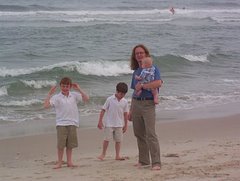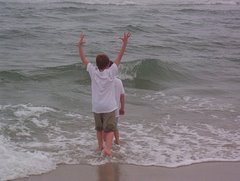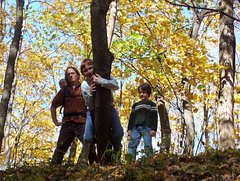The first time I read this story out loud, the evening before the retreat, I only sobbed briefly, at the very end of the story. However, when I read the story the next morning, I could hardly stop myself from sobbing. In a conversation with my father about it later that day he referred to this time as "verlorene Zeit" (lost time). It is, in a way, lost time. A sense I have had for as long as I can remember that our past becomes inaccessible to us as soon as we have left it "behind." And yet, there are these stories, these memories. What might they mean? And, more so, what might be their function? Perhaps to recapture "lost time?"
In 1968, I was 7, my parents, sister and I moved from the
town of Ahrensburg, 3 miles south to Meiendorf, a suburb of Hamburg. We weren’t told much about this move, other than that it would happen. So, to
this day I don’t know the reasons for it.
I suspect money was a big one as this move put us into
biking distance of the school were my father was a principal and it saved my
parents the rent they paid for the tiny 600 squarefoot apartment we all lived
in in Ahrensburg. For the move was to my father’s mother and step-father’s
house where we would not only have the whole first floor and basement to
ourselves but also have a huge fruits, vegetable and flower garden to roam
in. The house also came with a bunch of
mysterious sheds and a small stable that formerly housed pigs and chickens as
well as an old out-house. A paradise, in other words. I was very excited.
At the time , Meiendorf still was what it’s name suggests it
is; a village and farming community. Outside our house, just on the other side
of the street, was a huge field which, depending on the year, was used either
for corn, wheat or cattle and haymaking. Like all fields in northern Germany
this one too was surrounded by a “knick”—a
hedge-bank--trees and shrubs meant to break the wind that would
otherwise have blown away the precious soil northern Germany is known for.
We kids spent endless hours playing on the field and the
surrounding hedge-bank, climbing, building forts and tree-houses, pretending to
be Indians or Tarzan. There was one
particular tree, a huge 150 year old oak, we all revered as the most
special of them all. Mostly because it seemed impossible to climb.
But after a year of trying and also growing and becoming stronger, some of us
began to be able to climb it after all.
It took me longer than most of the other kids to get up into
the oak, but I finally succeeded. It was
a very happy evening when I returned and could fall asleep to thoughts of climbing the tree. My friends, however,
were already on to the next adventure.
It was a year of hay-making and so they had begun to make huge pile of
hay under the tree and now dared each other to jump off the tree—from various
heights—into the pile.
I thought I could—thought I would—when I climbed up the next
morning. But I could not. Glued to the lowest branch I was sitting on,
trying to measure and anticipate the jump, the fall and what could happen to me
I couldn’t do anything else but inch back towards the trunk and climb
down.
This lasted for days. My friends at first cheered me on, but
quickly lost interest and I could see in their faces the mix of surprise,
realization and disdain about Martin’s fear. Martin was and “Angsthase”—a
frightened hare.
I soon stopped attempting to jump and simply pretended I was
content climbing up and down the tree. But many early eenings when my friends
had already returned home for supper I would climb back on the tree, sit on the
branch, and bargain with myself whether
or not I would jump. It took about 10
attempts on, perhaps, four or five consecutive evenings, when on the 11th
climb and after leaning forward as far as I could without falling, I finally
let go of the branch. The drop lasted, at best, .5 seconds. But I remember it
to this day. My fear was at it’s peak, a sense of disbelief, a powerful sense
of euphoria, wind rushing past my ears, the smell of the hay and the absolute
softness of the landing. I jumped off the hay-pile, climbed up again and jumped
again—many times that evening and the next days.
One thing, though, I never showed my friends or let them
know I had jumped. My success, my victory, stayed my secret. Until about ten
years ago when I told my sons about this for the first time. Today, when we
visit my parents in Meiendorf, I often walk by the oak-tree which is still
there. But now it stands surrounded by cars, side-walks and buildings. And the field is no longer there. About 40
years ago it was sold and it disappeared under several apartment buildings.
Incidentally, buildings not much different from the ones we moved from in 1968.
And there was a lonely oak-tree not far from those buildings too, right by the play-ground.












1 comment:
Have you ever given yourself credit for waiting until you were ready to jump? Boldness without discernment is just showing off, not courage.
Post a Comment